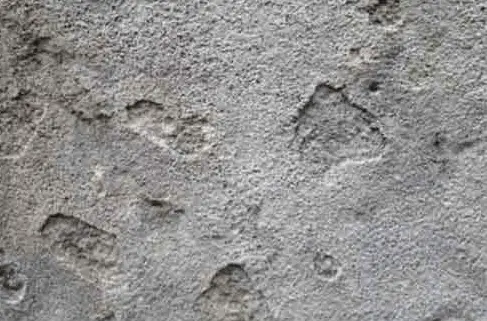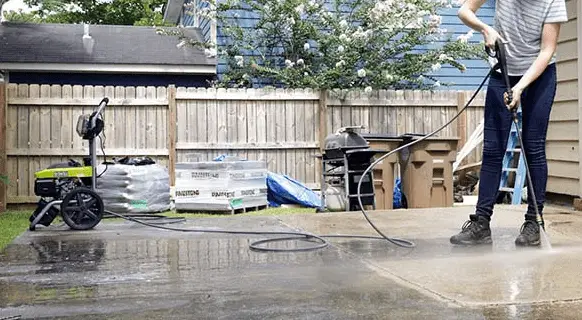Power washing is one of the most effective methods for the removal of deeply-engrained dirt on surfaces including hardscapes. However- it can cause a significant amount of damage to your concrete patio/driveway if not correctly used.
Avoiding surface degradation of your hardscapes when power washing requires one to use proper techniques. Below, we have a detailed guideline on everything you need to know about power washing concrete surfaces.

How to Power wash a Concrete Patio Safely
The first step when you’re looking to clean your concrete driveway or patio with a pressure washer is to choose a suitable tip. We recommend choosing a wide-angle tip.
Next, you need to prepare the materials that you’ll use to clean your concrete surface. Your choice should depend on what you’re trying to eliminate from your patio/driveway.
If you’re looking to get rid of mold, grime and algae- just water alone will get the job done. However if you’re dealing with oil stains- for example- you should consider including a soap attachment.
After deciding on your equipment/material, you can now get to work. You should ensure to use the proper technique for the best results. We recommend starting off at one end of your patio/driveway and proceeding in a uniform sweeping motion.
Meanwhile, the tip should be held at about 12-inches from the concrete surface for reduced streaking. What’s more, holding the tip too close to the surface can damage the concrete.
You should also spray at a slightly-tilted angle, as this will lessen the force with which the water jet hits the surface, thereby minimizing chances of damage to your concrete.
After you’ve pressure washed the whole surface, you can replace the tip with a wide-angle one to clean off the dirt material that has been loosened off the concrete.
Meanwhile- if you have a rather large patio/driveway that could make a manual wash rather tiring- consider hiring or investing in a rotating sweeping attachment. This equipment features a rotating head that can efficiently clean up large areas- quickly and uniformly.
What PSI is needed for cleaning concrete?

For a decent concrete wash you need to set the right pressure and flow rate.
Most commercial contractors recommend a pressure setting of no more than 3000 PSI as this range should effectively clean any concrete surface regardless of how stained it is or how much grime it has collected over time. The flow rate- meanwhile- should be set at no less than 3 GPM.
However- if it’s your painted, concrete walls that you’re looking to pressure wash without peeling off the paint; consider starting off with a lower pressure setting of about 1500 PSI and a flow rate of about 1.8 GPM.
Should you seal concrete after power washing?
Yes, sealing your concrete patio or driveway after power washing is a good concrete maintenance practice; as it safeguards the concrete from absorbing water, which then settles in between the holes to freeze and cause cracks.
As such, sealing a concrete patio is especially important for homeowners in colder regions where hard freezes are a frequent occurrence. Sealing also helps keep grease/oil stains at bay.
However- for great results- sealing has to be done correctly. To properly seal your concrete patio after power washing, take the following steps:
- After pressure washing your concrete surface, let it totally dry off before sealing.
- Consider when to seal, as temperatures affect how quickly sealers dry up. Remember you don’t want your sealer to dry up too fast after you apply it as this can leave behind visually unappealing lines. To avoid such an aesthetical mishap, consider working before mid-day when temperatures are lower.
- As a preparation step, use a paint stick to mix the sealer in the sealer bucket.
- Next attach a medium-nap roller onto your normal paint roller. Medium-nap rollers are preferable on concrete surfaces as they can work the sealer even into minute pockets within the surface of the concrete- unlike a normal paint roller.
- You’re now ready to do the actual sealing! Load the sealer onto your paint roller until it’s sufficiently saturated- not excessively. You should then roll the sealer onto the concrete surface in a zig-zag pattern, while ensuring that no part of the concrete surface is left unattended.
- Don’t forget to overlap the roller strokes, as this allows each subsequent coat to blend in perfectly with the preceding coat. However, you should- first off- allow each initial coat to dry, before applying the next layer if necessary.
What’s the difference between power washing and pressure washing?
While many people use the terms ‘power washing’ and ‘pressure washing’ interchangeably, there’s a slight difference between the two. A power washer’s jet wash uses heated water, while a pressure washer doesn’t. The pressure washer still uses water at high-pressure, but the difference is that it isn’t heated.
While hot water is the best for dissolving tough dirt and grime for a sparkling job, you cannot use heated water in a pressure washer. Every pressure cleaner model specify the maximum temperature of water to use. Surpassing the limit can lead to a permanent damage to your tool or an explosion.
Can you run vinegar through a pressure washer?
Yes, vinegar is a rather effective cleaning solutions when it comes to pressure washing concrete surfaces. It is an efficient mold and mildew ‘killer’, but can cause damage to your concrete if used in excess. As such, when making your solution, consider using about twice as much water as you do vinegar.
What’s more, unlike chemical solutions, vinegar is totally harmless to flora. You- therefore- don’t have to go through the extra struggle of covering lawn plants growing close to your patio.
It’s- however- important to note that for deep-seated dirt, grime, and oil stains- a simple vinegar solution might not get the job efficiently done. This is where a commercial concrete cleaner comes in.
For perfect outcome, read instructions on the label before you use your product. Further, you may contract professional cleaning services to do the cleaning.
I’m a little confused about the tips?
How to Power wash a Concrete Patio Safely
The first step when you’re looking to clean your concrete driveway or patio with a pressure washer is to choose a suitable tip. We recommend choosing a wide-angle tip.
Then, further down…..
After you’ve pressure washed the whole surface, you can replace the tip with a wide-angle one to clean off the dirt material that has been loosened off the concrete.